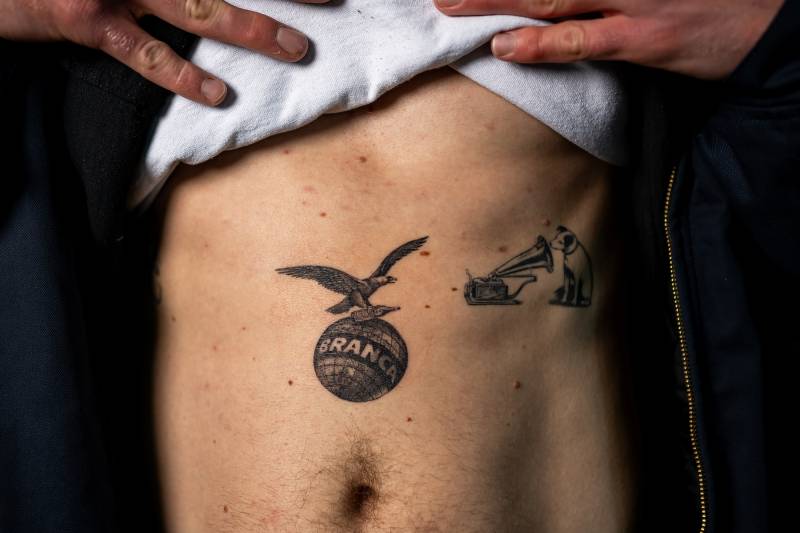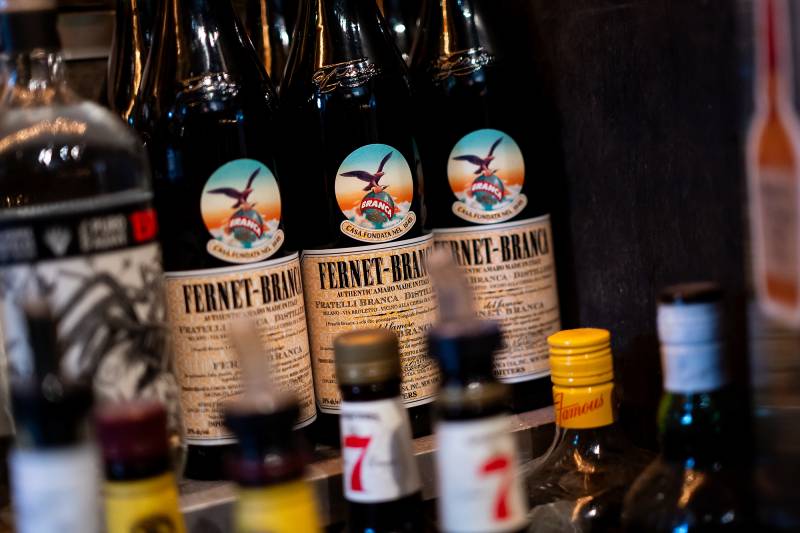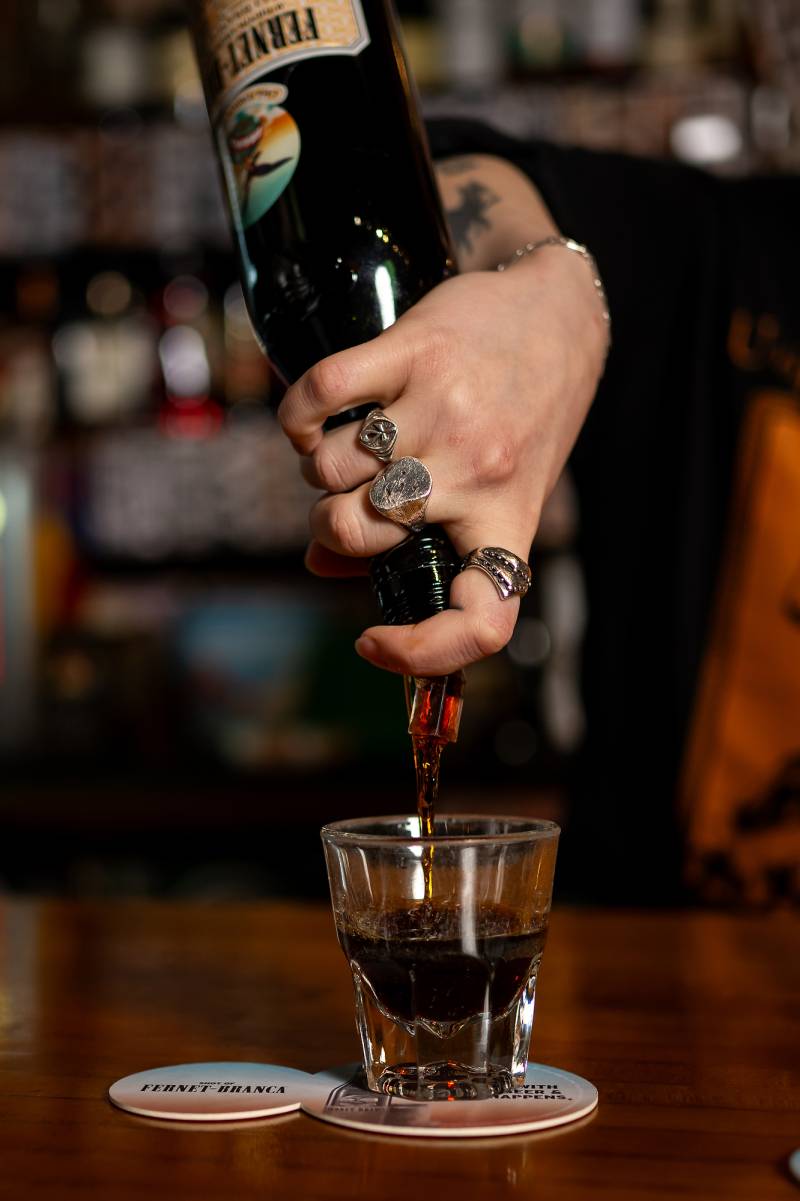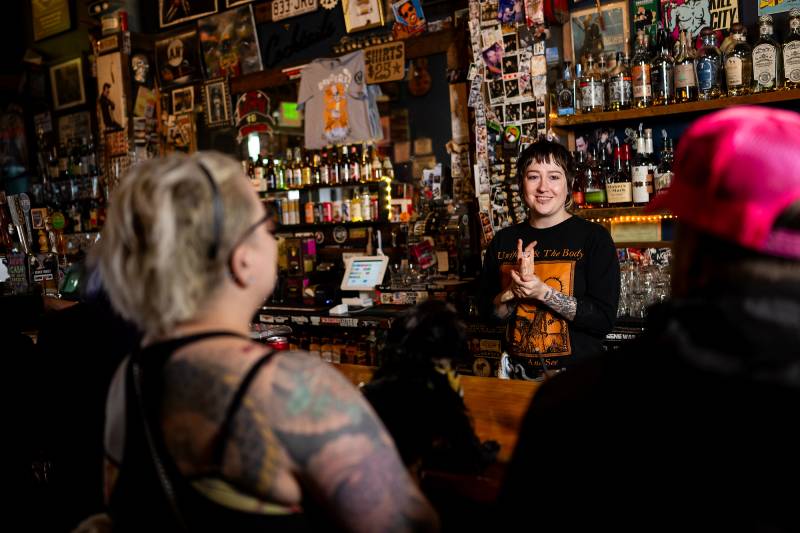Episode Transcript
Olivia Allen-Price: The San Francisco Bay Area has a rich history with cocktails and spirits. We claim to be the originators of the Martini and the Mai Tai, after all. But when it comes to spirits specifically, I’d argue only one has become quintessentially San Franciscan: Fernet-Branca.
It’s estimated that upwards of 35% of all the Fernet imported into the U.S. is consumed in San Francisco alone. Which — is surprising! If you know Fernet, you know it can be kind of a polarizing beverage, as we found when doing a taste test around the KQED office earlier this week …
Music
[waterfall of people saying they like it or hate it?]
Olivia Allen-Price: How did this bitter, herbal spirit become so popular in San Francisco? This week on Bay Curious, we’re going to find out. I’m Olivia Allen-Price. We’ll be right back.
SPONSOR BREAK
Olivia Allen-Price: We decided to give this story to the person on the Bay Curious team who most likes Fernet-Branca… Producer Amanda Font.
Amanda Font: If you’ve never had Fernet, let me describe it for you. It’s a dark, syrupy-looking liqueur with an intense herbal and strongly alcoholic aroma. It’s somewhat bitter and medicinal tasting with no sweetness and has sort of a cooling, numbing effect on the tongue. Personally, I kind of like it, but yeah, it’s an acquired taste.
Fernet is a type of amaro or Italian digestif, something meant to be sipped in small amounts at the end of a meal. Amaros are basically alcohol infused with different blends of herbs, barks or flowers, giving each one a unique flavor. The word amaro means ‘bitter’ in Italian.
Though Fernet is a designation given to a type of liqueur, from here on out, we’ll be talking about one specific brand… the most popular one in San Francisco: Fernet-Branca.
Felix Connor: It’s like a nice red wine where it’s not always soft and easy drinking, but it is always tasty.
Amanda Font: This is Felix Connor.
Felix Connor: I have been a bartender for just about ten years. Over ten years in San Francisco. And I’ve lived here for 12 of them.
Amanda Font: Felix tends bar at a couple places, including Bender’s Bar and Grill on South Van Ness in San Francisco’s Mission District. I met them there on a recent rainy afternoon because a lot of the lore around this spirit in San Francisco focuses on bartenders. It’s become so popular with folks in the bar industry that people sometimes refer to a shot of Fernet as the “Bartender’s handshake.” It’s like a little wink and nod that you’re compatriots.
Felix Connor: It’s something that is an acquired taste, and you have to know about it. And so there’s almost this like pride that comes with being like, no, I drink Fernet, and I like Fernet. And if I’m ordering Fernet, the person who’s pouring me a Fernet knows I’m probably a bartender or knows that I’ve been in the industry.
Amanda Font: Felix enjoys Fernet-Branca. But, and this turns out to be a pretty common story, they did NOT like it the first time they tried it.
Felix Connor: The first shot of Fernet I ever had was when I must have been 21 or 22 bar backing, and it was given to me by the bartender I was bar backing for, and I shot that shot, and… it was horrible. and I did not like it very much. And so the first 4 or 5 times I had Fernet was definitely… I didn’t like it.
Amanda Font: But it eventually grew on them. Now, they say, it’s definitely one of their go-to drinks.
Felix Connor: It’s very like herbaceous, and it does have that menthol aspect, but it’s subtle, and it’s got just so many layers of flavor.
Amanda Font: And they say that Bender’s serves a ton of it.
Felix Connor: I know that definitely a lot of people who are transplants to San Francisco are getting into it. Partially, I think, because it’s, it’s cool. You know, like people know, the bartenders do it, and the bartenders have been like key holders to the city for a long time in San Francisco.
Amanda Font: People know SF bartenders like Fernet, so that makes it kind of cool, and then patrons drink it and feel like they’re in the loop. And all this adds up to San Francisco consuming a boatload of the stuff. The city is second in consumption only to the entire country of Argentina, where they mostly drink it mixed with Coca-Cola. But why do bartenders here like it so much in the first place?
Felix Connor: I don’t know why or how it spread. But I do know it’s been like 25 years of this, at least, in the city.
Amanda Font: Yeah, about 25 years. So did all the San Francisco bartenders simultaneously have a dream one night in the late 90s where an angel told them to start drinking Fernet-Branca?
Antoinette Cattani: I’m sorry that my Italian voice cuts through cement. You got to tell me when I’m at a ten to just keep it to a five. I’m very aware.
Amanda Font: Of course not! This is America, baby. The real answer is brilliant marketing.
Antoinette Cattani: When I found Fernet, I was still in Los Angeles and I was working for the distributor that had it at the time, which was Southern Wine and Spirits.
Amanda Font: This is Antoinette Cattani. The evangelist bearing the joy of Fernet to the fine people of San Francisco. Early in her career, Antoinette had done sales and marketing for Jägermeister (you may have heard of it.) It’s a kind of German cousin to herbal Italian amaros like Fernet, but sweet.
Antoinette Cattani: And the gentleman who hired me for Jägermeister in the early nineties had just left Jägermeister and went to Fernet-Branca. And he said, Hey kiddo, you got to come in and talk to me about this brand. I’ve got something good for you.
Amanda Font: He tells her, “Drive out of LA, and come meet me in this parking lot in Orange County.”
Antoinette Cattani: So I go to Orange County. And he pulls out a little tiny bottle of Fernet and he says, Drink it. And so I downed it. He says take the whole thing. And I was like, okay. And then I was like, Oh, what was that like? My immediate response was like, What the (beep) was that?
Amanda Font: But within minutes, Antoinette says she knew there was something special about Fernet-Branca.
Antoinette Cattani: And then as I was walking away, I felt that immediate, like I call it, the glow Fernet brings. It’s like this glowy, like warm, fuzzy feeling. And I just, like, immediately got it.
Amanda Font: Even though it meant taking a big pay cut, she went to work for Fernet-Branca in sales and marketing, first in her home city of Los Angeles. But she wasn’t really getting the response she expected when she went out to sell it.
Antoinette Cattani: People hated me because I was so excited and so passionate about it that I would go into these restaurants and bars and talk to people about it. So they were like waiting to taste this amazing, like delicious… And I was at the Key Club and this guy literally wiped his tongue and said, ‘Why would you do that to me?’
Amanda Font: Antoinette says that kind of reaction was not uncommon. She got it over and over from bartenders in L.A.
Antoinette Cattani: And every time I came to San Francisco, it was the exact opposite. So my boss looked at me like we both had that moment. He’s like, You just need to move to San Francisco. And I was like, ‘I would love to move to San Francisco.’
Amanda Font: So she did. She was put in touch with some influential folks in the restaurant and bar industry, and they opened doors for her. She signed a few contracts with some high profile restaurant clients. And then, she started doing footwork at bars around the city.
Antoinette Cattani: My job was to know all the right bartenders, work with those bartenders and then do whatever I needed to do to get it behind the bar.
Amanda Font: Now, this is not to say that none of the bartenders here drank Fernet-Branca before Antoinette showed up. It had some history in San Francisco, going back to prohibition when it was sold in pharmacies as a medicinal tonic for stomach issues. A lot of quote-unquote tonics back in the day contained a bunch of herbs, and oh, just something to help take the edge off your pain… like opium or alcohol. So in the late ’90s, when Antoinette moved to San Francisco, it was already being enjoyed by the city’s old-school bartenders.
Antoinette Cattani: It was something that they drank behind the bar because it was more of a high. You didn’t really get drunk like Fernet. I mean, I’m sure if you drink a bottle, you could be sloppy drunk. But like Fernet was more of like, kind of takes the edge off and you get this high from it. You can still count your money, you could still function, you’re not sloppy. And there was just something about it that the bartenders really liked.
Amanda Font: But Antionette knew she had to make it popular among a younger, hipper crowd. So she, along with another woman she worked with, started making the rounds and doing promotion events. They handed out shots at the Bay to Breakers race. Or they’d sponsor Fernet drink specials during rock shows at Thee Parkside.
Antoinette Cattani: It was bartenders, art and music, always with Fernet-Branca. I knew if I married it into that community that, it would be endless.
Amanda Font: And when most liquor companies were just sending 2 hot girls into bars to do promotions, Antoinette was like, “No.”
Antoinette Cattani: And our thing was like, why are we just going to send 2 girls? Isn’t there as many women in the bar as there are men? So we were like sending in either two guys or one guy and a girl. We didn’t just send in two girls and do it that way. So we were very different in everything we did.
Amanda Font: She says they were approachable, energetic, and when they went to a bar to host an event, they’d get people really fired up about Fernet.
Antoinette Cattani: And then, and it is really contagious because whatever we’d be doing at this side of the bar, all of a sudden, everybody at the other end of the bar is interested. So next thing, you know, I’ve made my way down to every single barstool and I’ve talked to every single person in the bar, and every single person in the bar had a shot of Fernet.
Amanda Font: It started to become more popular among bar patrons, but the focus was still really on getting the bartenders and owners to love Fernet. If a bar would commit to buying 20 cases of Fernet at a time, they’d be part of the “Pouring ’20’s Club” and all the bartenders would get invited to this huge party once a year.
Antoinette Cattani: And so I had old school cars and everybody would dress up and really good deejays.
Amanda Font: Antoinette says when she started working for Fernet-Branca they were selling about 18,000 cases a year nationally. By her third year, they were up to 44,000. A good chunk of that increase was sales in San Francisco. Fernet-Branca and San Francisco were inextricably linked.
Antoinette Cattani: We’d get a group of bartenders and we’d go to New York or something like that, we’d walk in or even in Louisiana, we’d walk in and be like, Can we get a shot of Fernet? They’re like, Oh, bartenders from San Francisco.
Amanda Font: So there you have it. Antoinette no longer works for Fernet-Branca, but the impact of the marketing blitz she helped create has lasted. This nearly 180-year-old, strongly medicinal-tasting Italian spirit is a drink imbibed by cool people in the know. And even though Fernet-Branca’s popularity seems like it might be self-sustaining now, it doesn’t mean they’ve stopped marketing it to bartenders. Back at Bender’s in the Mission, bartender Felix tells me about the kind of things Fernet is still doing.
Felix Connor: We actually had a Fernet raffle earlier this year where they gifted us a skateboard as merchandise. So it was a beautiful Fernet skateboard, So we raffled it off to people who bought a shot of Fernet.
Amanda Font: And Felix mentioned these very cool-sounding metal coins minted by Fernet-Branca that can only be given to bartenders by Fernet at special events or promotions. And, like, it’s very exclusive.
Felix Connor: And so, like bartenders in the industry, we all know about the coins. Like, “I’ve never had a coin, but I’ve touched one before, and I want one.” And so there’s like all this really great lore. They’ve built this brand up, and I mean, that’s fun. You all want to be a part of something secret. You want a secret coin.
Amanda Font: Hey, Fernet, if you’re listening… I think Felix over at Bender’s deserves a coin, don’t you?
Felix Connor: One of my favorite things to do with tourists is to make them drink Fernet. So, like, no matter which bar, if I’m, like, talking to somebody and they’ve never been to San Francisco before, I’ll just be like, so you’ve never had Fernet before?
Amanda Font: Reactions, as you might guess, are mixed. So, as you’re out with friends this holiday season, maybe toast with a shot of Fernet-Branca…and get that warm and fuzzy glow people refer to. Or, if you’re one of the haters… Felix and I will toast for you.
(Felix and Amanda cheers)
Olivia Allen-Price: That was Bay Curious producer Amanda Font. Big thanks to Kelly O’Mara and Ana De Almeida Amaral for their help on this story.
Olivia Allen-Price: That’s a wrap for Bay Curious in 2024. The show will be off next week. Back in your feeds on Jan. 2. In the meantime, why not listen back through the Bay Curious archive? Did you know we’ve made more than 400 episodes! Just head to your favorite podcast app, and scroll back, scroll back — and see what goodies you can find.
Olivia Allen-Price: Bay Curious is made in San Francisco at member-supported KQED. Our show is produced by Amanda Font, Ana De Almeida Amaral, Christopher Beale and me, Olivia Allen-Price. Extra support from Jen Chien, Katie Sprenger, Maha Sanad, Holly Kernan and the whole KQED Family.
Olivia Allen-Price: We hope you have a joyful holiday season and do something special to ring in the New Year. Might we suggest … a shot of Fernet?



